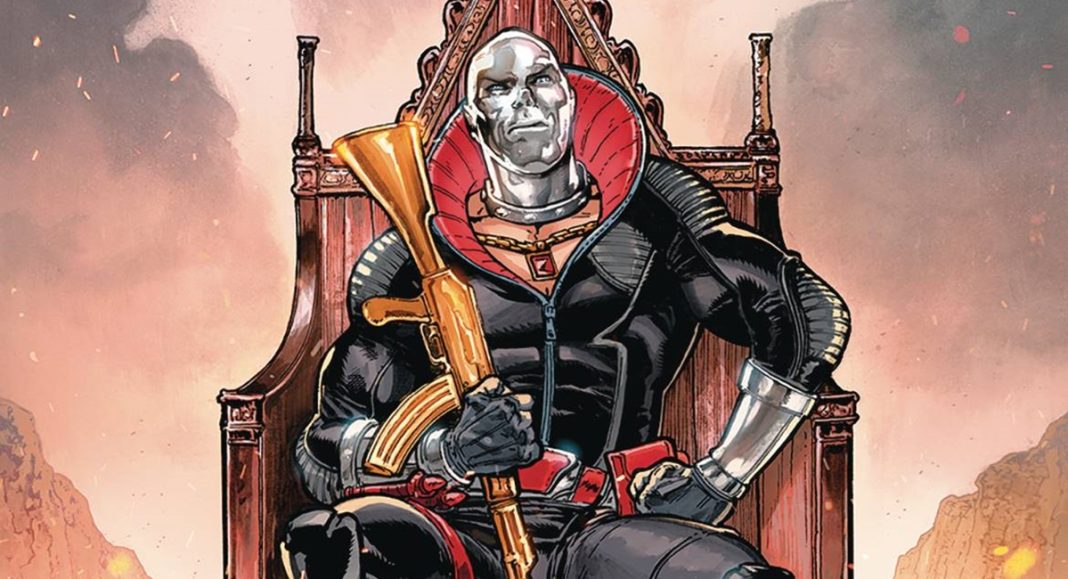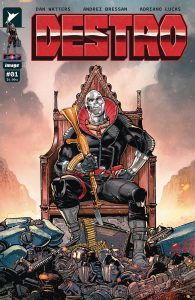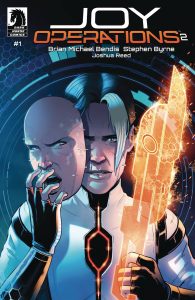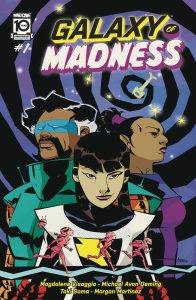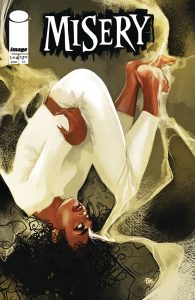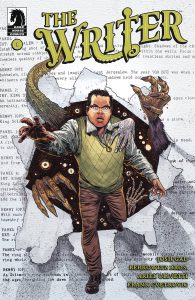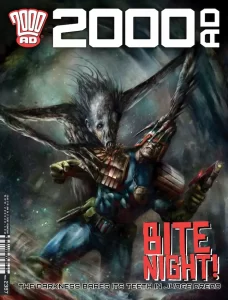This week’s main review is Destro #1. Plus, the Wednesday Comics Team has its usual rundown of the new #1s, finales and other notable issues from non-Big 2 publishers, all of which you can find below … enjoy!
 Destro #1
Destro #1
Writer: Dan Watters
Artist: Andrei Bressan
Colorist: Adriano Lucas
Letterer: Rus Wooton
Publisher: Image Comics – Skybound
Review by Zack Quaintance
I don’t think it’s a stretch to call these new Energon Universe books one of the hottest properties in comics, as they’ve wracked up major sales and a stream of critical praise. Daniel Warren Johnson’s Transformers title has been the headliner, a streamlined place to find a reinvented Transformers franchise all contained in one narrative. Void Rivals has been a fun book too, albeit one that lacks a boost by nostalgia and familiarity. Then you have the third franchise making up this new shared universe, G.I. Joe.
The new G.I. Joe comics (if you’ve somehow missed this) have taken a different approach, assembling its new take with a series of miniseries, rather than one book with one narrative like the other two. It’s been a really effective approach, enabling creators to delve into far more characters than they otherwise could with just one monthly book, where all the characters have to make sense in the same story. Both the Duke and Cobra Commander miniseries were very strong, as was Scarlett, which debuted earlier this month. And now comes Destro #1.
And I am happy to report that Destro #1 keeps the string of good books going. I think these comics stand well on their own, made as they are by top-tier action comics creators with high production values. But let’s be real, one of the big appeals for all of these comics is that they are doing new-but-recognizable things with characters you remember from when you were kids. And friends? Destro was always a favorite.
I’m sure I’m not alone here. That design was — and still is — fantastic. It doesn’t make a ton of sense (just imagine how sweaty it gets in there) but it’s shiny and cool and one of (if not the) most iconic looks within this franchise. This new book really builds out mythology around Destro, while modernizing him in fun ways. He’s always been a Scottish arms dealer, and so he is here — but he’s also interested in palace intrigue and politics and running Joa nation state.
On top of that, we also get all the familiar Destro trappings, or at least the family history and the frenemy setup with Cobra Commander. As it’s been with all these comics, this issue gives us glimpses of more iconic GI Joe characters than just Destro, including perhaps most notably the Tomax and Xamot, the Cobra twins.
Dan Watters is just such a great pick for this book, with his knack for giving the dark a sense of universality. And the art team of Andrei Bressan and Adriano Lucas once again delivers pages that look absolutely great, fresh off a stint on the fantastic horror mini, Dark Ride. These are there best pages left, elevated as they are by Rus Wooton, who does a great job lettering all these Energon Universe books.
If you’ve been reading these comics, you’ll definitely be picking up this one — and you won’t be disappointed. If you’re just a massive Destro fan (and somehow haven’t read any of the other new GI Joe comics), I think you’ll find this one to be worthwhile as well.
Verdict: BUY
 Joy Operations 2 #1
Joy Operations 2 #1
Writer: Brian Michael Bendis
Art and Colors: Stephen Byrne
Letters: Joshua Reed
Publisher: Dark Horse Comics
Review by Clyde Hall
Everyone loves it when a new series comes out swinging for the stands and surpasses all expectations. More often they premiere less fully formed, maybe only managing a conceptual beachhead, maybe missing the mark altogether. But if given a chance to find balance and a voice, some comics which were slow to ignite have become hits and earned fervent support.
This analogy seems appropriate for the first volume of Joy Operations, a five-issue series that grappled through presenting a complex setup but found firmer traction with each issue. The story of a futuristic corporation’s primary enforcer being saddled with the consciousness of a different corporation’s agent starts largely in the thoughts of main character Joy Corrigan. That rival enforcer, Hampton, has been inserted into Joy’s mind covertly. Her mission? Convince Corrigan that her own corporate leader, Kathryn Menteuse, is secretly embarking on a new technology which will upset precarious balancing between all the conglomerates, called Trusts. More, that due to Menteuse’s haste exploiting her innovation, the resulting raw, unrefined tech could destroy all humankind.
Over subsequent issues, Joy’s loyalty to her 0wn Jonando Trust is eroded as she and Hampton discover how dangerous Menteuse’s plan is and the risks she’s willing to take in her ruthless quest for power. In the end, Joy and Hampton learn to share one body effectively, stop the Jonando Trust’s threat to the planet, and retreat to the safety of Hampton’s Peachtree Trust. In the aftermath of the Joy Operation success, it’s theorized that Hampton’s consciousness will slowly fade from Joy’s mind. Since the process required the termination of Hampton’s own corporeal body, she has nowhere to go except extinct. The expected fade-out doesn’t occur however, leaving both continuing to exist within Joy’s body.
In the first issue of Joy Operations 2, the shared-consciousness operatives are working at forming a new relationship with Joy’s wife and husband, as well as her children from this threesome marriage union. All are still living safely in Peachtree but find that the violent resolution of the Menteuse threat continues to ripple across the Trustscape. Travel between Peachtree and Jonando is suspended. And given the immense public popularity of Menteuse, her demise has many overlooking the potential destruction avoided. Instead, people and the Trust leaderships are demanding those responsible answer for what they’ve done.
And while the matter has become an inter-Trust incident, Peachtree leaders busy themselves trying to duplicate the joined-consciousness success of the Operation as a way of creating a new generation of superior enforcers. Cold and calculating as that may be, it’s also practical if Jonando regime plots a retaliatory strike in response to the assassination of its leader.
One of the obstacles in how Brian Michael Bendis began the first series was how he established the futuristic stage he was setting, making the reader keep up on a forced march of concept while the narrative unfolded. He repeats that here, even mirroring the same opening scene aesthetics as the reader is dropped into the deep end. If you don’t have the life jacket of reading the first series buoying you, you’ll likely drown.
On the positive side, Bendis makes the revelations interesting with just enough hooks to pull one across the panels. For those who’ve read the first volume, the storyline should flow seamlessly forward. Some have described that first series as dumbed-down sci-fi that offered reconstituted Bendis concepts which he’s explored previously, and better. That may be true for hard science fiction fans and for those who have read much of his work.
As a more casual reader of both, I found the Joy Operations world initially challenging but deserving of exploration. Unlike much comics science fiction, this future vision feels less rooted in cautionary tales taking current societal trends or new tech to task. As presented, this is certainly no future utopia, yet neither is it purely dystopian. It actually holds a workable rationale which, given perhaps half a century of advancement in civilization and invention, doesn’t snap my suspension bridge of disbelief the way similar stories have. Overall, this entry continues Volume 1’s speculative action saga smoothly as a rocket shifting to its second stage.
The opening scenes of agent fusion experimentation was reminiscent of similar efforts in films like RoboCop 2, and with kindred results. The Joy Operation is less a procedure and more unique cooperative cognitive success between exceptional individuals. An outcome not assembly lined, but crafted by human will. A bane for corporate mindsets, and probably the least attractive options where all Trust leadership is concerned. That discordance, and those resulting within Joy’s family relationship as well as Hampton’s, will be driving forces in SJoy Operations 2 judging by this issue.
The illustration of Stephen Byrne is harmonic with the Bendis style of storytelling. Byrne builds relationships with facial expressions emoting one page, then breaks bones through dynamic Wire Fu action sequencing the next. The duo fuse their talents for visuals and the ongoing shared thought narration into a tense continuation of the first series. Taut family relationships are plucked to the breaking point, mirrored by similar tensions stoked between the operatives and the Trades with their unceasing games of brinkmanship. On both battlefronts, stakes are high and the Jenga blocks of symbiosis teetering for Joy and Hampton. Watching them navigate a minefield of synchronized cognition as orchestrated by Bendis and Byrne is the true joy of this continuing operation.
Verdict: BUY
 Self-Help #1
Self-Help #1
Writers: Owen King & Jesse Kellerman
Artist: Marianna Ignazzi
Colorist: Fabiana Mascolo
Letterer: Ian Chalgren
Publisher: Image Comics
Review by Steve Baxi
All of us know what it feels like to grind away at a crappy job. Maybe we have to do a side hustle that relies on our cracked phone, always being taken for granted or stepped on by people using us as a means to an end. But what if we had that and someone who looked just like us was busy living a much better life? Money, power, romance, all that we believe we deserve in the hands of someone who could have been us. It’s enough to make a person crazy, so crazy they might resort to… murder??
Self-Care is a classic California noir about mistaken identity and psychological repression. It’s clear from the covers, title page and artstyle that the title is hugely influenced by Hitchcock films and film noir, in particular works like The Wrong Man and Vertigo. This first issue setups a classic case of identity swap and gives us a window into the world of self-help culture and desperation.
More than anything, a noir is about style and this book is brimming with it. Marianna Ignazzi’s art evokes the mixed media and layered aesthetic of Disney animation, much like Greg Smallwood’s art for The Human Target series from last year. The tone established from this is immediately engaging, giving us plenty of little details to appreciate in the way characters move and interact. Fabiana Mascolo’s colors are rich approximations of classic technicolor but keep in line with the California setting. The color choice reminded me of the 50s color noir, A Kiss Before Dying with its integration of shady city spaces and desert hideaways.
All of this accomplished artistry is enough to keep us engaged even though the story might feel too familiar. While King and Kellerman haven’t yet given us any surprises a savvy noir fan hasn’t already seen, there’s still plenty to enjoy by simply relishing in the style, the tropes and the lovely page layouts.
Verdict: BUY
Wednesday Comics Reviews
Galaxy of Madness #1 (Mad Cave Studios): For a book called Galaxy of Madness, things seem pretty calm as of issue one. Magdalene Visaggio’s script right now is more space opera than space madness. A group of space archaeologists find a strange sarcophagus, for lack of a better term, and spend the issue debating what it is. None of the mysteries set up in this issue come across as particularly compelling. They get tossed off in favor of character dynamics for characters that come across as sci-fi stereotypes than actual people. What is compelling are the visuals by artist Michael Avon Oeming and colorist Taki Soma. So much science fiction looks derived from Star Wars that it’s grown tiresome. Oeming draws inspiration from Flash Gordon, Alex Toth’s designs for Space Ghost, and Jack Kirby in his designs for this futuristic worlds. Soma’s colors give the pages a beautiful combination Saturday morning pop and optimistic futurism. Their collaboration gives this book a real identity. —D. Morris
Misery #1 (Image Comics): Misery #1 expands the Spawn Universe with the story of a young superpowered woman looking for answers in the murder of her mother, and the police officer trying to look out for her while dealing with demons within her own home. Written by Todd McFarlane, the book sets up a hopeful protagonist facing nigh impossible odds of finding her mother’s killer, while also navigating the world with a unique superpower that may have some darker implications than she realizes. The art by Szymon Kudranski brings to life New York on the page with Fco Plascencia’s colors to round it all out. Letters by Andworld Design work well with the art succeeds in giving proper voice to the characters. —Bryan Reheil
The Writer #1 (Dark Horse Comics): Much like this book, I’m torn between my love for high concept self-insert fiction and my disdain for a thinly veiled screenplay aiming to go the comic adaptation route. While the latter point is pure speculation on my part, first time comic writers Josh Gad & Berkowitz Bros sure do write like effective creators in another space coming to comics without the pacing, foresight, and voice you attain from grinding out pages in this particular medium. At this moment in time, I think it’s a great idea to build an inherently Jewish superhero that unflinchingly uses Jewish mythology and Hebrew vocab in its narrative language; feels like a severely untapped aesthetic in today’s fantasy/hero markets! Though, I would’ve wished for a story that platforms its important, interesting, and big moments rather than put over its tepid dialogue and fairly bland jokes. You’d think with veteran Ariel Olivetti reaching back into his Punisher War Journal days for a stoic, painted look that the storytelling would find its footing– that the sequential art would save the narrative from its power fantasy. But between the poorly implemented 3D backdrops, the ai-generated looking King Solomon, and stuffy layouts, Olivetti’s shot selection regresses here into minimizing big moments, choosing unintentionally confusing methods for illustrating new concepts, and in some areas wasting space more than maximizing it. Truly baffling work here. They got Frank Cvetokovic out here using an all caps case font for regular volume and mixed case for softer tones, but over Olivetti’s painted sandstone world, and with so much packed into competition with one another, it’s a little too late for me, I’m afraid. I’m usually one to enjoy and adore first comic experiments where style is raw, and intent is transparent, but at $4, this little experiment is too expensive to be this cheap. —Beau Q.
The Prog Report
2000AD Prog 2387 (Rebellion Publishing): Welp, it’s been a fun, weird, and colorful ride through some…interesting…places, but this week marks the end of the excellent Intestinauts strip by writer Arthur Wyatt and artist/letterer Pye Parr. If you like comics that take the ridiculous seriously (as I very much do), you’ll have loved this one as much as I did. It was also a nice comic to fill the void left by Petrol Head, another great book Parr recently illustrated. It has the same excellent rainbow of colors and slightly off-kilter robotic sensabilities. All in all, this was a fun one that seems destined to be continued soon. As always, you can nab a digital copy of this week’s Prog here. —Zack Quaintance
Read more entries in the weekly Wednesday Comics reviews series!



